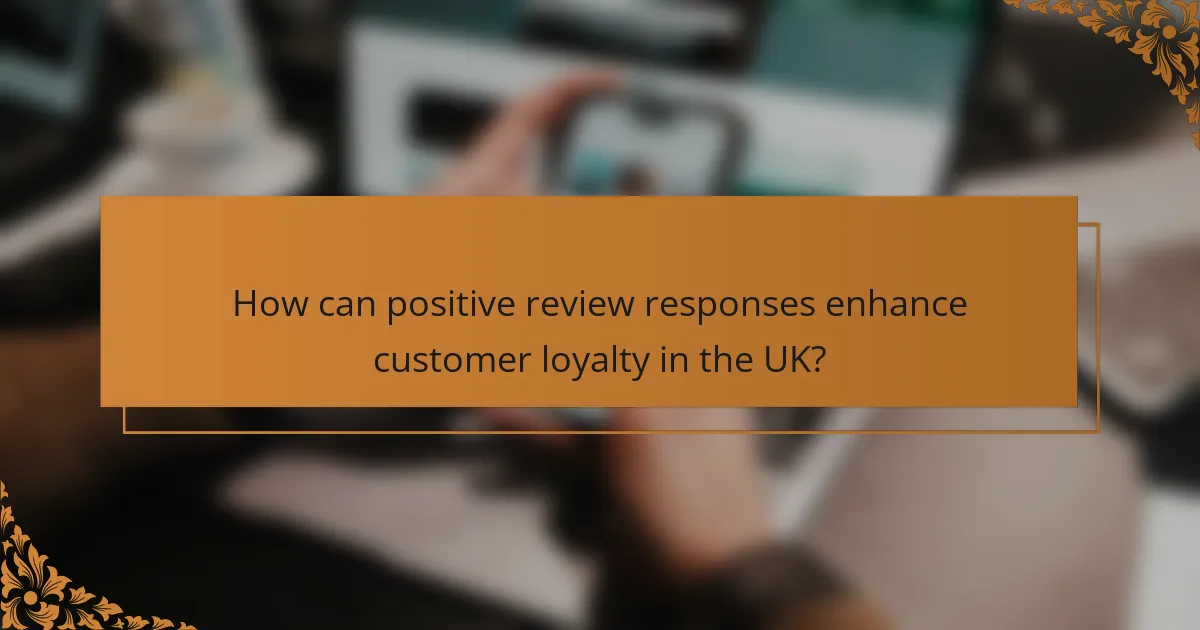Online Reputation Management plays a crucial role in building customer loyalty and engagement through positive review responses. By acknowledging and appreciating customer feedback, businesses can foster trust and a sense of belonging, encouraging repeat interactions. Personalized responses and active engagement on social media further enhance this relationship, creating a loyal customer base that feels valued and heard.

How can positive review responses enhance customer loyalty in the UK?
Positive review responses can significantly enhance customer loyalty in the UK by demonstrating that a business values its customers’ feedback. When customers see their reviews acknowledged and appreciated, it fosters a sense of belonging and trust, encouraging them to return.
Increased trust and credibility
Responding positively to reviews builds trust and credibility among potential customers. When a business engages with its customers, it shows transparency and a commitment to customer satisfaction. This interaction can lead to higher conversion rates as new customers feel more secure in their purchasing decisions.
For instance, a restaurant that replies to both positive and negative reviews can create an image of reliability. Customers are more likely to choose a business that actively communicates rather than one that remains silent.
Strengthened emotional connections
Positive review responses help forge emotional connections between customers and the brand. When customers feel heard and valued, they are more likely to develop loyalty towards the brand. This emotional bond can be particularly strong in the UK, where customer service is highly regarded.
For example, a local coffee shop that thanks customers for their positive feedback and shares their stories on social media can create a community feel. This approach not only enhances customer loyalty but also encourages word-of-mouth referrals.
Encouragement of repeat business
Engaging with customers through positive review responses can encourage repeat business. When customers see their feedback acknowledged, they are more likely to return, knowing their opinions matter. This can lead to increased customer retention rates.
Businesses can implement strategies such as follow-up emails thanking customers for their reviews or offering loyalty discounts to those who engage. Such practices can effectively turn one-time buyers into regular patrons, boosting overall sales and customer lifetime value.

What strategies improve engagement through positive reviews?
Engagement through positive reviews can be significantly enhanced by implementing personalized responses and leveraging social media platforms. These strategies not only acknowledge customer feedback but also foster loyalty and encourage further interaction.
Personalized responses to reviews
Personalized responses to reviews show customers that their opinions are valued. Tailoring replies to specific comments, whether they are positive or constructive, can enhance the customer experience and build trust.
Consider addressing the reviewer by name and referencing specific details from their review. For example, if a customer praises a particular product, mention it in your response to create a more engaging interaction.
Avoid generic replies that may come off as insincere. Instead, focus on expressing gratitude and inviting further dialogue, which can lead to increased customer loyalty.
Utilization of social media platforms
Utilizing social media platforms effectively can amplify the impact of positive reviews. Sharing customer testimonials on platforms like Facebook, Instagram, or Twitter not only showcases your brand’s strengths but also encourages others to share their experiences.
Engage with customers by responding to their posts and comments, creating a community around your brand. Regularly posting user-generated content can also enhance visibility and foster a sense of belonging among your audience.
Be mindful of the platform’s unique culture and audience. Tailor your content accordingly to maximize engagement and ensure that your messaging resonates with your target demographic.

How to effectively respond to negative reviews?
To effectively respond to negative reviews, acknowledge the customer’s concerns promptly and professionally. A well-crafted response can not only resolve the issue but also demonstrate your commitment to customer satisfaction.
Timely and professional responses
Responding to negative reviews quickly is crucial. Aim to reply within 24 to 48 hours to show that you value customer feedback. A timely response can mitigate the impact of the negative review and may even encourage the customer to update their rating.
Your tone should remain professional and empathetic. Use the customer’s name if possible, and express understanding of their feelings. This personal touch can help rebuild trust and rapport.
Offering solutions and follow-ups
When addressing a negative review, provide clear solutions to the issues raised. This could involve offering a refund, replacement, or any corrective action that aligns with your business policies. Make sure the customer knows you are taking their feedback seriously.
After resolving the issue, follow up with the customer to ensure their satisfaction. A simple message asking if they are happy with the solution can demonstrate your commitment to their experience and may encourage them to leave a positive follow-up review.

What tools can assist in online reputation management?
Several tools can enhance online reputation management by helping businesses monitor and respond to customer feedback effectively. Utilizing these tools can improve visibility, gather insights, and foster customer loyalty.
Google My Business for local visibility
Google My Business (GMB) is essential for businesses aiming to enhance their local visibility. By creating and optimizing a GMB profile, companies can manage their online presence across Google, including Search and Maps.
Key features include responding to reviews, posting updates, and sharing photos. Regular engagement on GMB can significantly influence local search rankings and attract more customers.
To maximize effectiveness, ensure your business information is accurate and up-to-date. Encourage satisfied customers to leave positive reviews, which can enhance your reputation and attract new clients.
Trustpilot for customer feedback
Trustpilot is a popular platform for collecting and showcasing customer feedback, helping businesses build trust and credibility. By inviting customers to leave reviews, companies can gain valuable insights into their products and services.
Responding to reviews on Trustpilot, whether positive or negative, demonstrates commitment to customer satisfaction. This interaction can enhance customer loyalty and encourage repeat business.
To leverage Trustpilot effectively, consider integrating it with your website and sharing positive reviews on social media. This not only boosts your online reputation but also provides social proof to potential customers.

What are the key metrics for measuring online reputation?
Key metrics for measuring online reputation include review ratings, the volume of reviews, and customer sentiment analysis. These metrics provide insights into how customers perceive a brand and can guide strategies for improvement.
Review ratings and volume
Review ratings reflect the average score given by customers across various platforms, typically on a scale from one to five stars. A higher average rating indicates a positive reputation, while a lower score can signal issues that need addressing.
The volume of reviews is equally important, as a larger number of reviews can enhance credibility. For instance, a business with a 4.5-star rating from hundreds of reviews is generally seen as more trustworthy than one with a similar rating from just a few reviews.
Customer sentiment analysis
Customer sentiment analysis involves evaluating the emotions expressed in reviews and feedback. This analysis can be performed using tools that categorize sentiments as positive, negative, or neutral, helping businesses understand overall customer feelings toward their brand.
Monitoring sentiment trends over time can reveal shifts in customer perception, allowing businesses to respond proactively. For example, if negative sentiment increases following a product launch, it may indicate a need for immediate action, such as addressing product issues or improving customer service.

How does online reputation impact subscription-based businesses?
Online reputation significantly influences subscription-based businesses by affecting customer trust and perceived value. A positive reputation can lead to increased customer acquisition and loyalty, while a negative one can deter potential subscribers and increase churn rates.
Influence on customer acquisition
A strong online reputation attracts new customers by building trust and credibility. Prospective subscribers often rely on reviews and ratings to make informed decisions, with many prioritizing businesses that showcase positive feedback. For instance, a subscription service with a high average rating can see conversion rates improve by a substantial margin compared to competitors with lower ratings.
To enhance customer acquisition, businesses should actively manage their online presence by encouraging satisfied customers to leave reviews. Engaging with reviews, both positive and negative, demonstrates responsiveness and commitment to customer satisfaction, further boosting appeal.
Retention rates and churn reduction
Online reputation plays a crucial role in retaining existing customers and minimizing churn. Subscribers are more likely to remain loyal to a brand that consistently receives positive feedback and addresses concerns promptly. A strong reputation can lead to higher retention rates, as customers feel valued and understood.
To reduce churn, businesses should implement strategies such as personalized communication and regular engagement with subscribers. Offering incentives for feedback and addressing any negative reviews can also foster a sense of community and loyalty, ultimately enhancing customer retention.

What are the best practices for managing online reviews?
Effective management of online reviews involves actively monitoring feedback, responding appropriately, and encouraging customer engagement. Implementing best practices can enhance your brand’s reputation and foster customer loyalty.
Regular monitoring of review platforms
Consistently monitoring review platforms is crucial for understanding customer sentiment and addressing concerns promptly. Set up alerts for new reviews on major sites like Google, Yelp, and TripAdvisor to stay informed.
Consider dedicating time each week to check these platforms, ensuring you can respond to both positive and negative reviews. This proactive approach can help mitigate potential issues before they escalate.
Encouraging customer feedback
Actively encouraging customer feedback can lead to more reviews and enhance your online reputation. Simple strategies include sending follow-up emails after purchases or providing incentives for leaving reviews.
Make it easy for customers to share their experiences by including links to review sites on your website and social media. Aim for a balanced mix of positive and constructive feedback to create a realistic portrayal of your business.

How can businesses leverage positive reviews for marketing?
Businesses can effectively use positive reviews as a powerful marketing tool to enhance their brand image and attract new customers. By showcasing these testimonials, companies can build trust and credibility, which are essential for customer loyalty and engagement.
Showcasing testimonials on websites
Displaying customer testimonials prominently on your website can significantly influence potential buyers. Consider placing them on your homepage, product pages, or dedicated testimonials section to ensure maximum visibility. This approach not only highlights customer satisfaction but also reinforces your brand’s reliability.
When showcasing testimonials, use a mix of text and visuals, such as customer photos or video testimonials, to create a more engaging experience. Aim for a diverse range of reviews that reflect different aspects of your offerings, helping potential customers relate to the experiences shared.
To optimize the impact of testimonials, keep them concise and focused. Highlight key phrases or quotes that resonate with your target audience. Regularly update the testimonials to keep content fresh and relevant, which can further enhance customer trust and engagement.
